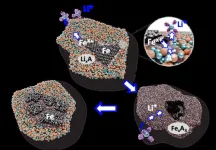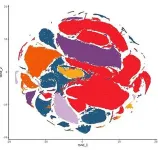(Press-News.org) News Release
Journal of Raptor Research
For immediate release
Contact: [Zoey T. Greenberg]
science.writer@raptorresearchfoundation.com
360.739.7170
Parents of the Year: Scavenging Raptors Lead a Collaborative Home Life
Let’s face it, scavengers have a bad reputation. However, according to a new paper published in the Journal of Raptor Research, pairs of scavenging falcons called Chimango Caracaras (Milvago chimango) demonstrate an endearing level of collaboration while raising their chicks. In their paper, “Biparental Care in a Generalist Raptor, the Chimango Caracara in Central Argentina” Diego Gallego-García from the Center for the Study and Conservation of Birds of Prey in Argentina (CECARA), and co-authors, share results from a two-year study on the nesting behaviors of Chimango parents. This is the first study of its kind for the species. As a group, caracaras remain relatively unstudied, yet they are notably curious, creative, and charismatic birds. The existing knowledge gaps on topics of caracara life history limit our collective understanding of their population dynamics, ecological contributions, and species-specific conservation status. More studies like this one could expand our caracara consciousness.
Chimango Caracaras are common across central Argentina where this study occurred, and they are one of nine species of living caracaras, all of which live in the Americas and nowhere else. Generally, raptor species with a large size difference between the sexes exhibit a clear division of parental responsibility — the larger female incubates the eggs, takes care of the nestlings, and defends the nest, while the smaller male hunts for prey. Chimango caracaras, however, show little difference in size between the sexes and are both predators and scavengers, which means their food sources are relatively unpredictable. Therefore, dividing the workload of feeding and caring for young could be the best path to success. This is what Gallego-García’s team set out to investigate.
The team observed 70 Chimango Caracara nests during the breeding seasons of 2016 and 2017 and confirmed that pairs shared most parental responsibilities at the nest, namely incubation, brooding, and food deliveries. In addition to splitting the workload, the male and female chimangos in this study demonstrated a detailed understanding of their chicks’ needs throughout all stages of development. For example, during the early days of nestling development, when they could not thermoregulate properly, parents devoted more time to brooding in the morning, when temperatures were lower. Additionally, as chicks grew, they underwent an uptick in food requirements during peak development, and the chimango parents matched this by bringing in more food.
Studying the home lives of raptors can help illuminate the big picture of how food webs are faring. According to Gallego-García, “the importance of studying raptor reproductive biology goes beyond the conservation of the species themselves. Raptors occupy the highest position in the food chain, and thus control populations of prey species below. We need to know what happens during reproduction, which is one of their most important and fragile life stages.” Gallego-García also says that many landowners in the area are happy to learn more about their backyard caracaras, a trend that will hopefully continue. “Most of them call us when they find an injured chimango, or a dead nestling, or a new active nest. In return, we invite them to attend banding days with nestlings.”
Gallego-García and coauthors suggest future research on reproductive success across larger parts of this specie’s range and would like to delve into survival estimates of fledglings after they disperse from the breeding area and become independent. Hopefully more support for such research will lead to a stronger foundational knowledge of these unique raptors and their contributions to ecosystem health, the details of which we are just beginning to understand.
###
Paper
Diego Gallego-García, Mikel Larrea, Claudina Solaro, and José Hernán Sarasola "Biparental Care in a Generalist Raptor, the Chimango Caracara in Central Argentina," Journal of Raptor Research 58(2), 176-184, (2 May 2024). https://doi.org/10.3356/JRR-23-16
Notes to Editor:
1. The Journal of Raptor Research (JRR) is an international scientific journal dedicated entirely
to the dissemination of information about birds of prey. Established in 1967, JRR has published
peer-reviewed research on raptor ecology, behavior, life history, conservation, and techniques.
JRR is available quarterly to members in electronic and paper format.
2. The Raptor Research Foundation (RRF) is the world’s largest professional society for raptor
researchers and conservationists. Founded in 1966 as a non-profit organization, our primary
goal is the accumulation and dissemination of scientific information about raptors. The
Foundation organizes annual scientific conferences and provides competitive grants & awards
for student researchers & conservationists. The Foundation also provides support & networking
opportunities for students & early career raptor researchers.
END
Deciphering the genetic causes of common neurodevelopmental conditions like autism and common mental illnesses like bipolar disorder has been challenging – not least because of the size and complexity of the human brain – but a new package of research from a global group makes notable progress. Across Science, Science Translational Medicine, and Science Advances, more than a dozen reports from the PsychENCODE Consortium – established in 2015, and dedicated to illuminating the molecular ...
Study combines analyses of multiple genomic platforms over multiple brain regions to probe biological processes and underlying mechanisms of stress-related disorders
Results lay groundwork for future diagnostics and targeted treatments
BELMONT, Mass. (May 23, 2024) A comprehensive approach that examines the intersection of multiple biological processes is necessary to elucidate the development of stress-related disorders. In a new study, investigators from McLean Hospital, a member of the Mass General Brigham healthcare system, ...
CORVALLIS, Ore. – What if a common element rather than scarce, expensive ones was a key component in electric car batteries?
A collaboration co-led by an Oregon State University chemistry researcher is hoping to spark a green battery revolution by showing that iron instead of cobalt and nickel can be used as a cathode material in lithium-ion batteries.
The findings, published today in Science Advances, are important for multiple reasons, Oregon State’s Xiulei “David” Ji notes.
“We’ve transformed the reactivity of iron metal, the cheapest metal commodity,” he said. “Our electrode can offer a higher energy density ...
BELMONT, Mass. (May 23, 2024) Schizophrenia is a complex disease with variable presentations, and the diverse nature of this mental health disorder has made understanding the mechanisms that cause the disease, and subsequently developing effective treatments, especially challenging. In a new study, published May 23 is Science, a team led by McLean Hospital researchers used comprehensive genetic and cellular analyses to shed new light on the intricate molecular mechanisms underlying schizophrenia. Their new work provides a map for how the genes known to increase risk of schizophrenia affect specific cells within the brain.
“We discovered which cell types express ...
The world’s population has increased by more than 2.6-fold in the last 60 years. The growing trend continues – projections indicate that the number of people living on our planet will grow to 9 billion by 2037 from 8 billion in 2022. These numbers underscore the need for considering family planning; however, there have been limited breakthroughs in contraception in recent decades. Specifically for men, there are no oral contraceptive pills available.
In a study published in the journal Science, researchers at Baylor College of Medicine and collaborating institutions show in animal models that a novel, non-hormonal sperm-specific approach offers a promising option ...
Artificial intelligence approaches demonstrate how plant science has evolved
Machine learning also reveals how model systems have changed and how countries differ in terms of research focus and impact
#####
In your coverage, please use this URL to provide access to the freely available paper in PLOS Biology: http://journals.plos.org/plosbiology/article?id=10.1371/journal.pbio.3002612
Article Title: Assessing the evolution of research topics in a biological field using plant science as ...
Using the James Webb Space Telescope, University of Copenhagen researchers have become the first to see the formation of three of the earliest galaxies in the universe, more than 13 billion years ago. The sensational discovery contributes important knowledge about the universe and is now published in the prestigious journal Science.
For the first time in the history of astronomy, researchers at the Niels Bohr Institute have witnessed the birth of three of the universe's absolute earliest galaxies, somewhere between 13.3 and 13.4 billion years ago.
The ...
The Epstein-Barr virus can cause a spectrum of diseases, including a range of cancers. Emerging data now show that inhibition of a specific metabolic pathway in infected cells can diminish latent infection and therefore the risk of downstream disease, as reported by researchers from the University of Basel and the University Hospital Basel in the journal Science.
Exactly 60 years ago, pathologist Anthony Epstein and virologist Yvonne Barr announced the discovery of a virus that has carried their names ever since. The Epstein-Barr virus (EBV) made scientific history as the first virus proven to cause cancer in humans. Epstein and Barr isolated the pathogen, ...
New Haven, Conn. – A new analysis has revealed detailed information about genetic variation in brain cells that could open new avenues for the targeted treatment of diseases such as schizophrenia and Alzheimer’s disease.
The findings, reported May 23 in Science, were the result of a multi-institutional collaboration known as PsychENCODE, founded in 2015 by the National Institutes of Health, which seeks new understandings of genomic influences on neuropsychiatric disease. The study was published alongside related studies in Science, Science Advances, and Science ...
AUSTIN, Texas — Stress-related disorders like post-traumatic stress disorder and clinical depression are complex conditions influenced by both genetics and our environment. Despite significant research, the molecular mechanisms behind these disorders have remained elusive. However, researchers at Dell Medical School at The University of Texas at Austin have broken new ground with a study that sheds light on the intricate differences occurring in the brains of people with PTSD and depression compared to neurotypical controls. The study, published this week in Science, could provide potential avenues for novel therapeutics and biomarkers.
“Understanding why some people develop ...






